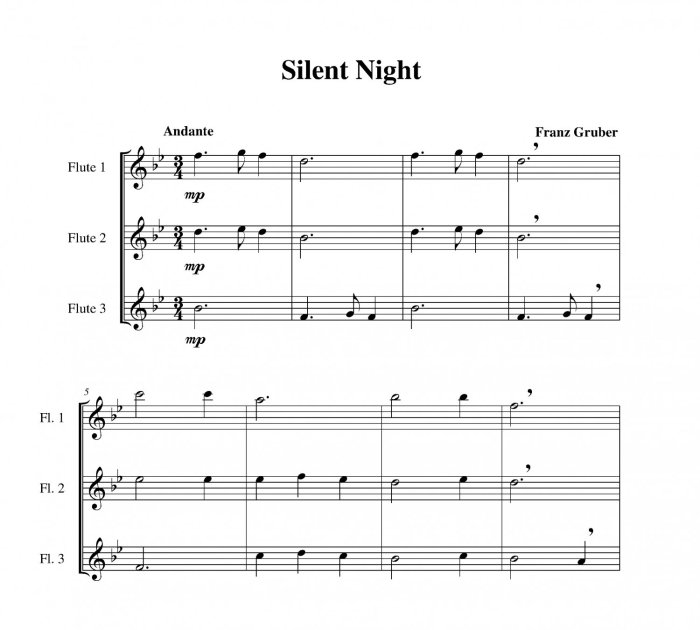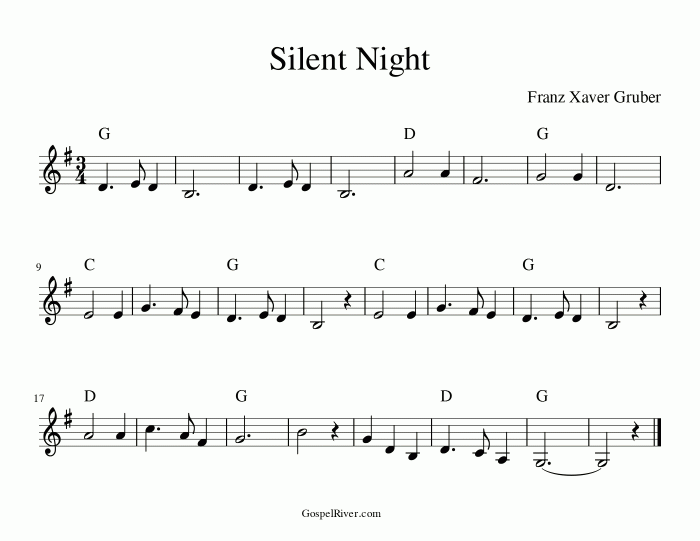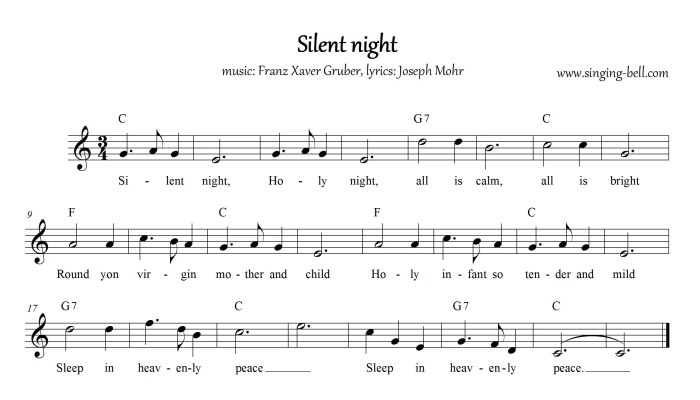Immerse yourself in the timeless beauty of “Silent Night” as we embark on a comprehensive journey through its sheet music. From its historical origins to its enduring cultural significance, this iconic carol has captivated hearts for centuries. Join us as we delve into the musical intricacies, lyrical depth, and performance techniques that make “Silent Night” a beloved masterpiece.
In this exploration, we will uncover the secrets hidden within the notes and symbols on the page. We will examine the key, tempo, and form that shape its enchanting melody. We will dissect the harmony, melody, and rhythm that create its distinctive sound.
And we will explore the profound meaning and symbolism embedded in its lyrics.
Historical Context
Silent Night, Holy Night is a beloved Christmas carol composed in 1818 by Franz Xaver Gruber, with lyrics by Joseph Mohr. It was first performed on Christmas Eve of that year in the small Austrian town of Oberndorf bei Salzburg.
The song quickly gained popularity throughout Europe and the United States, and has since become one of the most recognizable and cherished Christmas carols in the world. It has been translated into over 300 languages and has been recorded by countless artists.
Cultural Significance
Silent Night has played a significant role in popular culture. It has been featured in numerous films and television shows, and has been used as the inspiration for many other works of art.
The song’s message of peace and goodwill has resonated with people of all faiths and cultures. It has been sung at peace rallies and during times of war. It has also been used to comfort those who are grieving or who are in need of hope.
Musical Structure
Silent Night is a beautiful and timeless Christmas carol that has been sung by people of all ages for generations. The song’s simple yet elegant melody and heartfelt lyrics have made it a beloved holiday classic.
The song is written in the key of C major and has a tempo of 6/8. It is written in ternary form, with an A-B-A structure. The A section is the main melody of the song, and the B section is a contrasting middle section.
Harmony
The harmony of Silent Night is simple yet effective. The song uses mostly basic chords, such as C major, G major, and F major. However, the use of secondary dominants in the B section creates a sense of movement and interest.
Melody
The melody of Silent Night is one of its most recognizable features. The song’s simple yet elegant melody is easy to sing and remember. The melody is mostly stepwise, with a few leaps of a third or fourth.
Rhythm
The rhythm of Silent Night is also simple and straightforward. The song is mostly in 6/8 time, with a few measures of 4/4 time in the B section. The use of syncopation in the B section creates a sense of movement and interest.
Lyrical Content
The lyrics of “Silent Night” are a simple yet profound reflection on the birth of Jesus Christ and the peace and hope it brought to the world.
Themes of Peace, Hope, and Love
The song’s first verse establishes the serene setting of the Holy Night, with the sleeping world enveloped in silence and the stars twinkling above.
- Peace: The lyrics evoke a sense of tranquility and peace, as the world rests peacefully on this special night.
- Hope: The birth of Jesus brings hope for a better future, as the song suggests that the “savior is born.” This hope is a beacon of light in the darkness of the world.
- Love: The song’s message of love is expressed through the tender bond between the Holy Family and the shepherds who come to worship the newborn child.
Sheet Music Analysis
The sheet music for “Silent Night” is written in the key of G major and has a 4/4 time signature. The melody is simple and straightforward, making it easy to sing and play. The harmonies are also relatively simple, but they add a touch of richness and depth to the song.
The sheet music includes fingering suggestions for both the right and left hands. These fingering suggestions can help you to play the song smoothly and efficiently. The dynamics are also marked in the sheet music, so you can see how loud or soft to play each section of the song.
Notation
The notation for “Silent Night” is relatively straightforward. The melody is written in the treble clef, and the harmonies are written in the bass clef. The notes are all written in whole notes, half notes, and quarter notes. There are no accidentals in the song, so all of the notes are played as written.
Fingering
The fingering suggestions for “Silent Night” are designed to help you to play the song smoothly and efficiently. The fingering suggestions are written above the notes in the sheet music. The numbers correspond to the fingers on your right hand (1 = thumb, 2 = index finger, 3 = middle finger, 4 = ring finger, 5 = pinky finger).
Dynamics
The dynamics for “Silent Night” are marked in the sheet music using the following symbols:
- p = piano (soft)
- mp = mezzo piano (moderately soft)
- mf = mezzo forte (moderately loud)
- f = forte (loud)
The dynamics are used to create a sense of contrast and drama in the song. The soft sections are played gently and tenderly, while the loud sections are played with more power and energy.
Performance Techniques
To fully capture the essence of “Silent Night,” performers must employ a range of techniques to convey its profound message and evoke its timeless beauty.
These techniques encompass vocal interpretation, piano accompaniment, and overall musicianship, each contributing to the emotional depth and expressive power of the performance.
Vocal Interpretation
- Soft and Intimate Delivery: The vocal line should be sung with a hushed and reverent tone, reflecting the peaceful and tender nature of the lyrics.
- Phrasing and Dynamics: Careful attention to phrasing and dynamics is crucial, allowing the singer to convey the emotional nuances of the text.
- Ornamentation: Subtle ornamentation, such as appoggiaturas and trills, can add depth and expressiveness to the vocal performance.
Piano Accompaniment
- Simple and Sparse: The piano accompaniment should be simple and sparse, providing a gentle backdrop to the vocal line.
- Pedaling: Judicious use of pedaling can create a rich and resonant sound, enhancing the atmosphere of the piece.
- Arpeggiation: Arpeggiating chords can add movement and interest to the accompaniment, while maintaining its subtle and supportive role.
Overall Musicianship
- Emotional Connection: Performers must establish a deep emotional connection to the piece, allowing their interpretation to convey the full range of sentiments expressed in the lyrics.
- Musical Sensitivity: A keen musical sensitivity is essential, enabling performers to capture the subtle nuances and delicate balance of the composition.
- Collaboration: Effective collaboration between vocalist and pianist is paramount, ensuring a cohesive and unified performance that brings the piece to life.
Variations and Arrangements
The enduring popularity of “Silent Night” has inspired countless variations and arrangements, each adding a unique flavor to the beloved carol.
These adaptations have played a pivotal role in expanding the song’s reach, appealing to diverse audiences and showcasing its versatility.
Notable Variations
- Classical Arrangements: Orchestral and choral versions, such as those by Franz Xaver Gruber and John Rutter, have elevated the song’s grandeur, making it a staple of Christmas concerts.
- Jazz Interpretations: Artists like Miles Davis and Wynton Marsalis have infused “Silent Night” with jazz harmonies and improvisations, giving it a modern and soulful twist.
- Pop Covers: From Mariah Carey to Michael Bublé, pop singers have recorded their own renditions of the carol, introducing it to new generations and solidifying its place in popular culture.
- Contemporary Adaptations: Electronic music producers and indie bands have experimented with “Silent Night,” creating electronic dance music (EDM) versions and stripped-down acoustic interpretations that appeal to younger listeners.
Cultural Impact
“Silent Night” has become an integral part of Christmas celebrations worldwide, transcending religious and cultural boundaries. Its serene melody and heartwarming lyrics have made it a beloved song in countless countries, contributing to its enduring cultural significance.
In religious services, “Silent Night” holds a special place as a traditional Christmas carol. Its poignant message of peace and goodwill resonates deeply with worshippers, creating a profound and reflective atmosphere during holiday observances.
Concerts and Cultural Events
Beyond religious settings, “Silent Night” is a popular choice for concerts and cultural events. Its timeless appeal and universal message make it a crowd-pleaser, evoking a sense of nostalgia and holiday spirit. From symphony orchestras to choirs, various musical ensembles perform “Silent Night” during the Christmas season, showcasing its enduring popularity.
Influence on Other Music

“Silent Night” has left an indelible mark on the world of music, inspiring countless composers and musicians throughout history. Its haunting melody and heartwarming harmonies have served as a foundation for a wide range of musical works.
Influences on Classical Music
The song’s serene and contemplative nature has resonated with classical composers, who have incorporated its elements into their own compositions. For instance, Franz Liszt’s “Christmas Tree” suite features a variation on “Silent Night,” showcasing the song’s versatility in a classical setting.
Influences on Popular Music
The song’s enduring popularity has also influenced popular music. In the 1950s, Elvis Presley recorded a rock and roll version of “Silent Night,” bringing the song to a new generation of listeners. More recently, artists such as Taylor Swift and Mariah Carey have released their own interpretations of the classic carol.
Influences on Film and Television
The song’s emotional resonance has made it a staple in film and television soundtracks. It has been featured in countless holiday movies and specials, including “It’s a Wonderful Life” and “A Charlie Brown Christmas.” Its appearance in these beloved works has further cemented its place in popular culture.
Influence on Other Christmas Carols
“Silent Night” has also influenced the composition of other Christmas carols. Its simple yet effective melody and harmonies have served as a model for many later carols, including “Away in a Manger” and “The First Noel.”
Educational Value

Silent Night offers an invaluable educational resource for musicians and music enthusiasts alike. Its simple yet profound melody and accessible harmonic structure make it an ideal vehicle for teaching fundamental music theory concepts.
Through the study of Silent Night, students can grasp the intricacies of tonality, chord progressions, and melodic development. Its clear and concise form provides a solid foundation for understanding musical structure and the principles of composition.
Music Theory
- Introduction to major and minor keys
- Understanding chord functions and progressions
- Analysis of melodic contour and phrasing
Music History
- Exploration of the origins and evolution of Christmas carols
- Historical context of Silent Night’s composition and its impact on popular culture
- Study of the role of music in religious and cultural traditions
Performance
- Developing vocal techniques through proper breathing and intonation
- Learning basic piano or guitar accompaniment skills
- Enhancing ensemble performance through coordination and balance
Contemporary Interpretations

In the contemporary era, “Silent Night” has undergone numerous reinterpretations by modern artists, who have infused the song with fresh perspectives and styles.
These interpretations aim to cater to diverse audiences, preserving the song’s core message of peace and hope while exploring its relevance in the modern context.
Electronic Interpretations
- DJ Tiësto’s 2014 remix transforms “Silent Night” into an uplifting trance anthem, featuring soaring synths and a driving beat.
- Kygo’s 2019 version blends tropical house elements with the song’s traditional melody, creating a serene and atmospheric rendition.
Pop Interpretations
- Mariah Carey’s 1994 cover became a holiday classic, showcasing her signature vocal acrobatics and infusing the song with a pop sensibility.
- Ariana Grande’s 2013 version features a delicate and ethereal arrangement, highlighting the song’s poignant lyrics.
R&B Interpretations
- Usher’s 2008 rendition transforms “Silent Night” into a soulful ballad, featuring his rich vocals and a gospel-infused arrangement.
- H.E.R.’s 2021 version combines R&B and jazz influences, creating a warm and intimate interpretation.
Closing Summary
As we conclude our analysis of “Silent Night,” we are left with a profound appreciation for its enduring power. Through its timeless message of peace, hope, and love, it continues to resonate with audiences worldwide. Whether sung in a hushed sanctuary or performed on a grand stage, “Silent Night” remains an enduring testament to the transformative nature of music.
FAQ
What is the key of “Silent Night”?
The song is written in the key of F major.
What is the tempo of “Silent Night”?
The tempo is typically around 60 beats per minute, giving it a serene and contemplative feel.
What is the form of “Silent Night”?
The song follows a simple verse-chorus form, with two verses followed by a chorus.
What is the significance of the lyrics “Silent night, holy night”?
These lyrics evoke a sense of peace and tranquility, setting the tone for the rest of the song’s message of hope and love.